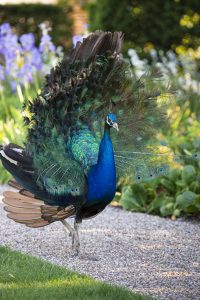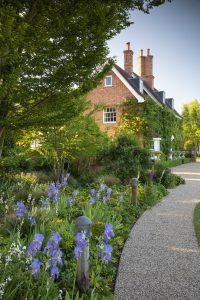Holm House Gardens in Suffolk

Holm House, Drinkstone, Suffolk
Building on success
The classic Janey Auchincloss design at Suffolk’s Holm House has been developed by the property’s new owners and is now maturing beautifully alongside a more recently acquired six-acre wildflower meadow with a tranquil lake at its heart
WORDS Barbara Segall PHOTOGRAPHS Richard Bloom
What a difference water makes to a property. The garden at Holm House in Suffolk, already intriguing and productive, has been transformed by the addition of a lake complete with an island and wildlife-sympathetic plantings.
It was 2015 when Rebecca and Phil Shelley arrived at Holm House. Back in 2007, their predecessors had asked Suffolk-based garden designer Janey Auchincloss to provide a masterplan for what was then a brand new garden. “The original brief I had from the previous owners was for a garden around a Queen Anne-style new-build property, constructed on the site of a derelict bungalow,” explains Janey. “The planting of standard holm oaks (Quercus ilex) on the driveway was what inspired them to name their new home Holm House.”
“I felt that it was important to try to retain and integrate some of the existing planting into the design,” she continues. “There was a curvaceous cypress hedge and some amazing trees and shrubs, including the most fabulous euonymus species with glowing autumn colours. They gave the gardens a feeling of instant maturity and helped to soften the impact of the building.”
The Shelleys found that Janey’s design had stood the test of time. “When we arrived we did a little infilling and patching in the existing borders, as well as some hard pruning and trimming to shape and rejuvenate some of the trees and shrubs,” Rebecca recalls. The garden had sustained some damage from hungry wildlife, so adding deer- and rabbit-proof fencing across the entire eight acres was the couple’s priority. Then, in their first autumn, they planted some 10,000 bulbs that would bloom in waves over a long period the following spring.
“When we came here the house was set right up against one of the boundary hedges. It was sited on the edge of the property and the boundary it was closest to had an evergreen laurel hedge, which darkened the house and that part of the garden,” says Rebecca. “In 2016 we were able to buy the neighbouring six-acre field. This then placed the house at the heart of the garden, making it so much more comfortable in its setting.”
Other major projects included the installation of the ornamental kitchen garden and a two-acre lake. The lake project, however, wasn’t as simple as the Shelleys had hoped. Rebecca was convinced that the field was flat and she believed it would be a simple matter to extend the existing duck pond on the north-east corner of the field. “We had no idea how complex it would be or how many hoops we’d have to jump through,” she admits.
On the advice of friends, the couple contacted a local but nationally accredited firm, Miles Water Engineering, who, after gently explaining that the ‘flat’ field was in fact not level at all, drew up plans for a two-acre lake within the six-acre setting. Once planning permission had been granted, the topsoil was scraped off and stored in piles. Taking away the diggings from the lake, which is 2.5 metres at its deepest point, would have been expensive and impractical, so the spoil was spread thinly across the field and mounded at the outer edges to form a bund.
The base of the lake was made watertight by puddling the clay. It took four months to fill using water from the Shelleys’ borehole and that of a neighbour. To prevent the growth of blanket weed and algae as the water settled, Rebecca and Phil used a special colouring product called Dyofix, which blocks one end of the light spectrum, making it impossible for blanketweed to gain a foothold. Happily it is safe for humans, pets and wildlife – including the hundreds of rainbow trout that are now resident in the lake. The rainbow trout were chosen especially because, unlike carp, they don’t feed on the bottom of the lake, scuffing it up and making the water cloudy.
A thin layer of topsoil was eventually spread across the top of the spoil and sown with a mixture of 20 wildflower species, specifically chosen to suit the clay-based soil here that is water-logged in winter and dries out in summer. The mix, supplied by local firm Urban Forestry, included ox-eye daisies, ragged robin, cowslip, meadow buttercup and yellow rattle. The wildflower meadow is cut each year after it has seeded and the cuttings are removed afterwards. On the raised bund that surrounds the lake, Rebecca and Phil have planted hundreds of trees to encourage wildlife and to give them a breathtaking view from the house.

Holm House, Drinkstone, Suffolk
“Of all the things we have done here we are most proud of the installation of the lake, the design and establishment of the wildflower meadow and the peripheral woodland planting. Our aim was to have something beautiful to look at but also to focus on the wildlife – the birds, including swans, moorhens, coots, herons, ducks and geese, as well as insects, that we see daily.”
Phil and the two fox-red Labrador pups that the couple acquired during lockdown enjoy daily swims in the lake. Phil says that being in the water as swallows and other summer avian visitors dip and dive alongside you is one of the lake’s purest delights.
Other areas of the garden that are of particular importance to Phil and Rebecca include the kitchen garden and the cutting garden. Phil is both the designer and chief grower of the ornately caged fruit and vegetable garden. The netting here, hung on custom-made Gothic-style decorative supports, protects the crops from pigeons and the home team of peacocks and peahens, who rival pigeons when it comes to the destruction of leafy crops!
Prior to the lockdowns of 2020 and 2021, Rebecca was the main processor of homegrown fruit and veg into fresh, frozen and other preserved forms of produce. “But during lockdown Phil became much more interested in how the veg was going to be used and that has continued,” she explains.
Rebecca’s pride and joy is her cutting garden. The planting scheme here ensures that there is a selection of flowers and foliage throughout the seasons. Her cutting year begins with bulbs, such as hyacinths, tulips and narcissus, coupled with stems of fragrant Daphne bholua. There are around 60 repeat-flowering roses, which Rebecca regularly cuts back hard, among them ‘Lady Emma Hamilton’. She also uses six varieties of block-planted peonies, as well as highly scented lilies. In late summer, dahlias, agapanthus and Japanese anemones come to the fore. The cut flowers, combined with foliage gathered from all around the garden, are used by Rebecca in some half-dozen arrangements throughout the house, all year round.
To the north, set between the house and the cutting garden, is the Woodland Walk where rhododendrons, azaleas, ferns and bulbs thrive alongside a curving gravelled path. This area, along with the Winter Garden on the south side of the house, was also designed by Janey Auchincloss. Framed by a rim of box spheres and alliums and interspersed with upright grasses, it has become one of the Shelleys’ sitting-out areas of choice, with a large wooden ‘gin and tonic’ bench at its heart. The south-west orientation of this area means that the setting sun adds back-lighting in all seasons. Mature trees and shrubs, including magnolia and birches, encircle the Winter Garden, offering strong structure. Each spring Rebecca washes the trunks of the birches as far up as she can reach and these are also illuminated at night.
“As the designer, seeing this garden taken on and developed by the new owners is possibly the best outcome,” says Janey. “The Shelleys have worked with my original layout but have also added to it. It is fabulous to be able to visit and see the planting developing and maturing.” n
Holm House, Garden House Lane, Drinkstone, Bury St Edmunds, Suffolk IP30 9FJ. Opens for the National Garden Scheme on 5 June 2022, 10am to 5pm. Private group visits are also available by appointment. ngs.org.uk

Peacock

Iris

Aquilegia ‘Ruby Port”

Sculpture


Holm House, Drinkstone, Suffolk
